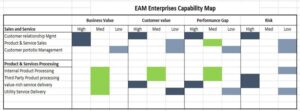Last Updated on March 14, 2024 by Techcanvass Academy
Business Capability Analysis is conducted to assess the enterprise’s capabilities for various purposes. It is performed to assess and analyze the performance of an organization, set goals, and identify gaps.
Business Capability Analysis thus helps the organization in addressing performance gaps and prioritizing investments that further result in better business advantages and fruitful business outcomes.
Moreover, a business capability model of any organization helps in the translation of strategy into execution as it addresses the question of “What” the business does, rather than defining how it is done. This gives the leaders a better clarity of what is possible and how to address the performance gaps. An organization needs Business Capability Analysis to improve the performance of its core concepts in order to meet its business objectives.
Become a CBAP Expert and take your career to the next level and ensure continued success in the field of business analysis with the CBAP Certification Training Course From TechCanvass
In this guide, let’s understand the concept of business capability analysis…
What Is Business Capability Modelling?
A business capability is the measure of the ability of an entity (department, organization, person, system) to achieve its objectives, especially in relation to its overall mission.
In simple terms, Capabilities represent what the business does (or needs to do) to fulfill its objectives and responsibilities. It defines the ‘What’ a business can do, whereas a business process denotes the ‘How’ of a business i.e. how a business executes a particular task or activity.
We can define Business Capabilities as:
- Intangible assets that cannot be seen
- They are different from processes
- These are constant over time
But most importantly, business capabilities help organizations create value and goodwill in the market.
Moreover, business capability involves business capability modeling, which is a technique for representing the organization’s business model. It involves all the functions that a business is performing, and what it can perform in a logical grouping structure. A business capability model is defined as the foundation for enterprise transformation.
If you are wondering how these business capability models are utilized, then business executives or architects usually use these business capability models for strategic long-term planning up to 3-5 years in advance. It helps in identifying the capabilities that require the most significant improvements in the long run.
You may also like our blog related to “Top Requirement Management Tools“
What is Business Capability Analysis?
Capstera defines business capability analysis as the assessment of individual business capabilities and an integrated set of enterprise business capabilities models to evaluate their strategic importance, business process maturity, resource adequacy, level of IT support, and cost factors.
This assessment is conducted to evaluate if the current capabilities can help the organization achieve a business goal or objective. This analysis can help in understanding the adequacy of the existing capabilities. The gaps will need to be addressed.
The key elements which need to be considered while conducting business capability analysis are as follows:
Using Capabilities
Capabilities do not deliver value uniformly. Each capability will have different levels of value, and that needs to be considered while conducting the analysis.
Performance Expectations
Each capability is expected to perform at a certain level. If the capability is not performing at the expected level, the gap is identified so that it can be improved upon.
Risk Model
If a capability is not performing at the expected level, it is a risk for the organization. The new product effort may not be able to address the needs as expected. The common categories of risks are – Business Risk, technology risk, Organizational Risk, and Market risk.
Strategic Planning
Business capability analysis enables Business analysts to develop a change strategy. The capability maps and performance gaps help in the planning process to achieve the strategic goals.
Capability Maps
Capability maps are the outputs of the capability analysis exercise. The capability map is a visual model and shows the following elements:
- The capabilities and the value delivered
- Performance gaps
- Associated risks
Examples of Business Capability
Axin Info Inc is a software product company. It has a range of software products for the Oil and Gas industry. What can we say about its capabilities? The capabilities for Axin could be product support, product sales, etc. These capabilities enable Axin to achieve its business objectives.
Capability View
What can we say about processes? Does the answer lie in how Axin offers product support?
Axin has a dedicated help desk portal to offer production services. The customer logs in to the portal to raise a support ticket (Input) and the support engineer closes the ticket once the issue is resolved (output).
The capabilities are realized by a business process and performed by a role i.e. an individual or team in the organization.
What Can You Achieve with Business Capability Mapping?
A few things that you can achieve with the help of business capability mapping are as follows:
- Figure out what the business is doing currently and what can be done for meeting the current and future challenges.
- Defining the ‘what’ that a business does, rather than focusing on how the business does it.
- Provides a common basis for discussing and planning.
- Provides a direct link between strategy and execution of the strategy in an organization.
- Business capability mapping helps in assessing risks and preparing for future endeavors.
Benefits Of The Business Capability Model
The benefits of business capability analysis are as follows:
Provides A Common Language
Business capability analysis helps provide a common language that further helps in aligning the business objectives with various organizational processes.
Helps Focus on Improvement Opportunities
Business capability analysis helps in identifying performance gaps, which can be addressed for better improvement opportunities.
Identifying What Is Important for The Business
One can identify strategic themes and performance metrics against the business capabilities for a better decision-making process in the organization.
Accurate Depiction of a Program’s Scope
One can map out the program objectives against the business capabilities to produce a more complete and accurate picture of the program scope.
Greater Flexibility
In the case of IT projects, IT departments are usually overwhelmed with a number of existing projects or assets. It is hard for them to figure out how new projects or applications will fit their IT landscape or what will be the impact. This is where business capabilities can help IT departments by increasing their ability for embracing new projects.
Improved Investments
Business capabilities act as a key to linking strategy to execution. Thus businesses can align projects with their business objectives or needs and can further ensure that investments are planned with greater visibility so that there is no wastage of resources for the projects.
Case Study
Axin Info Inc is a software product company. It has a range of software products for the Oil and Gas industry. In the last couple of years, Axin has been growing rapidly and now has more than a hundred thousand users using its products. The rapid growth has also led to research and new product ideas. A new product was launched three months back. However, the response to this new product is not so great.
A business analyst is hired to help the organization in addressing this need. While conducting the strategy analysis, the BA creates a capability map to identify the capabilities gaps.
The capability map for Axin looked as shown below:

Customer relationship management is one of the capabilities shown on the map. It is crucial for Axin as it helps in leveraging existing customer relationships to see new products/services. So, the business value is marked as a high value.
Axin does not have integrated customer relationship management, so the performance gap is high.
The case study describes that the new product sale is not as expected. An efficient customer relationship management capability helps cross-sell (Selling new products/services to existing customers). It is identified as a risk because of the performance gap (of not having the desired level).
You can read our post related to Tips for Solving CBAP Case Study-Based Questions and growing your BA Skills.
Learn Business Capability with Techcanvass
Techcanvass is an IIBA Endorsed Education Provider (EEP), iSQI ATP (for Certified Agile Business Analyst Training) as well an Agile Testing alliance partner for CP-SAT certification training in Selenium. You can explore our business capability and business analysis certification training courses.
Opting for a Techcanvass course can help you create business capability models in 4 simple steps. They are as follows:
Understand the Needs
The first step is to identify and understand the needs of the business. It is important to know where your business is heading. You can do this by reviewing the business strategy and goal documents or involving the departments that are responsible for defining the company’s strategy.
Define Your Business Capabilities
The second step is to brainstorm around the major business capabilities that your business needs to focus on. Defining the business capabilities is again a long process, but with the help of the Techcanvass Course, you will be able to summarize what it is that your company wants to achieve or determine what processes and people are in place.
Assess Your Capabilities
After defining your business capabilities, you can assess these capabilities as per the defined criteria on the basis of later planning and analysis.
Link Capabilities to Applications
Lastly, the most important step is linking the capabilities to applications as it is going to help create a bridge between your business and IT.
Conclusion
To conclude, businesses that invest time to identify and develop their business capabilities will be in a good position to enjoy the benefits of improving their core services and business outcomes. Moreover, business capabilities and business capability mapping help enterprise architects to position themselves as strategic advisors for the business by explaining what can be prioritized and what cannot for better future outcomes.


